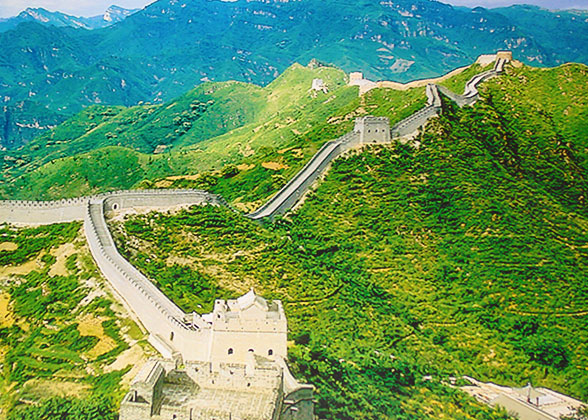Great Wall in Tianjin
The only part of Tianjin where one can visit the Great Wall is Jixian County, in the extreme northern reach of the city. Some experts think the Tianjin Great Wall was first built during the Sui Dynasty (581 – 618), while others believe it was built in the Northern Qi Dynasty (550 – 577). It was not until the Ming Dynasty (1368 – 1611) that the Great Wall in Tianjin became a complete defensive system due to numerous additions and improvements.
 |
| Huangyaguan Great Wall |
Facts about the Tianjin Great Wall
![]() Most sections were built during the Ming Dynasty, and measure 44,054.09 yards (40,283.06 meters) long, which accounts for 1/200 of the length of the Ming sections.
Most sections were built during the Ming Dynasty, and measure 44,054.09 yards (40,283.06 meters) long, which accounts for 1/200 of the length of the Ming sections.
![]() Nowadays, there are over 200 Ming Dynasty Great Wall sites in total, including one pass, 10 fortresses, 85 watchtowers, four beacon towers, 15 fire pits, 40 hearths, 42 living sites, 11 water cellars, and four wells.
Nowadays, there are over 200 Ming Dynasty Great Wall sites in total, including one pass, 10 fortresses, 85 watchtowers, four beacon towers, 15 fire pits, 40 hearths, 42 living sites, 11 water cellars, and four wells.
![]() All the stone watchtowers, which used to be the sentry posts for soldiers to stand guard, have featureless walls. There are no stairs leading to the top. Rope ladders were used to ascend and descend. The ladders were taken away when not in use, which is a clever design to prevent possible sneak attacks.
All the stone watchtowers, which used to be the sentry posts for soldiers to stand guard, have featureless walls. There are no stairs leading to the top. Rope ladders were used to ascend and descend. The ladders were taken away when not in use, which is a clever design to prevent possible sneak attacks.
![]() The brick watchtowers are wider than the stone ones. The remains of door locks and window bolts all can be seen within, demonstrating that the brick towers were the living places of the frontier soldiers.
The brick watchtowers are wider than the stone ones. The remains of door locks and window bolts all can be seen within, demonstrating that the brick towers were the living places of the frontier soldiers.
![]() By the 1980s', 3,308 yards (3,025 meters) of ramparts plus 12 watchtowers along Taipingzhai and Huangyaguan Pass had been renovated. Now, hiking from Taipingzhai to Huangyaguan has become a popular activity for visitors.
By the 1980s', 3,308 yards (3,025 meters) of ramparts plus 12 watchtowers along Taipingzhai and Huangyaguan Pass had been renovated. Now, hiking from Taipingzhai to Huangyaguan has become a popular activity for visitors.
This section got its name, Huangyaguan (Yellow Cliff Pass), because the yellow cliff rocks to its east look golden in the sun. The pass also has a nickname, Eight Diagram City, because the staggered lanes inside form a maze resembling the Eight Diagram. This design allows an ingenious defense. If enemies invaded the pass, they would easily lose their way, which gave the garrison a second chance to turn the tide of battle.
Taipingzhai is now the east gate of Huangyaguan. It stretches from Banlagang Mountain on the east to the Widow Tower. Hike westward for two hours at most, and you will reach Huangyaguan Pass.
The nine-mile (15-kilometer) section at Qingshanling Village, to the south of Huangyaguan, provides another popular hiking route to feel the wildness of the Great Wall. Most parts have totally collapsed with no trace of stairs. For safety, bring some companions and some mountaineer equipment with you.
Most Parts are Badly Damaged
Hundreds of years of weathering and human activities have made this great construction 'bruised and scarred'. In Tianjin, most of the walls and watchtowers have already collapsed, leaving piles of scattered bricks among the hill stones. Some sections have cracked due to the growth of tree branches. Lacking an awareness of its cultural significance, people living at the foot of the Great Wall have removed its bricks at will. Some parts were even destroyed to create farm land.
Better Protection is Required
Although local government has implemented some renovation work at Huangyaguan and Taipingzhai to prevent this old construction from further deteriorating and to better showcase its beauty, a great deal is still in its original condition. Overall management from the government is very necessary. In addition, villagers living under the Great Wall need to make more of an effort to protect the wall.
![]() Further Reading: Tianjin Travel Guide
Further Reading: Tianjin Travel Guide